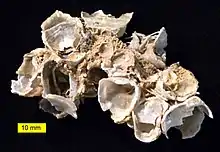Roadian
In the geologic timescale, the Roadian is an age or stage of the Permian. It is the earliest or lower of three subdivisions of the Guadalupian Epoch or Series. The Roadian lasted between 273.01 and 266.9 million years ago (Ma). It was preceded by the Kungurian and followed by the Wordian.[3]
| Roadian | |||||||||||||
|---|---|---|---|---|---|---|---|---|---|---|---|---|---|
| Chronology | |||||||||||||
| |||||||||||||
| Etymology | |||||||||||||
| Name formality | Formal | ||||||||||||
| Usage information | |||||||||||||
| Celestial body | Earth | ||||||||||||
| Regional usage | Global (ICS) | ||||||||||||
| Time scale(s) used | ICS Time Scale | ||||||||||||
| Definition | |||||||||||||
| Chronological unit | Age | ||||||||||||
| Stratigraphic unit | Stage | ||||||||||||
| Time span formality | Formal | ||||||||||||
| Lower boundary definition | FAD of the Conodont Jinogondolella nanginkensis | ||||||||||||
| Lower boundary GSSP | Stratotype Canyon, Guadalupe Mountains, Texas, USA 31.8767°N 104.8768°W | ||||||||||||
| Lower GSSP ratified | 2001[2] | ||||||||||||
| Upper boundary definition | FAD of the Conodont Jinogondolella aserrata | ||||||||||||
| Upper boundary GSSP | Guadalupe Pass, Guadalupe Mountains, Texas, USA 31.8658°N 104.8328°W | ||||||||||||
| Upper GSSP ratified | 2001[2] | ||||||||||||

Stratigraphy
In 1961, the regional timescale used for the southeastern US had the Wordian and Capitanian as subdivisions of the Guadalupian.[4] Efforts to correlate the Permian stratigraphy of the southeastern US with that of Russia led to the conclusion that between the Wordian stage and the Russian Artinskian stage, another stage needed to be introduced.[5] This stage, the Roadian Stage, was established in 1968 and took its name from the Road Canyon Formation in Brewster County, Texas, formerly considered the lower (oldest) part of the Word Formation.[6] The stage was added to the internationally used IUGS timescale in 2001.[7]
The base of the Roadian is defined as the place in the stratigraphic record where fossils of conodont species Jinogondolella nankingensis first appears. The global reference profile for the base (the GSSP) is located in Stratotype Canyon in the Guadalupe Mountains, Texas (31°52′36″N 104°52′36″W). The top of the Roadian (the base of the Wordian Stage) is at the first appearance of fossils of conodont species Jinogondolella aserrata.
Biodiversity
Olson’s Extinction, a worldwide loss of terrestrial vertebrate life occurred during the Early Guadalupian (Roadian, Wordian).[8]
References
- "Chart/Time Scale". www.stratigraphy.org. International Commission on Stratigraphy.
- "GSSP for Roadian Stage". International Commission on Stratigraphy. Retrieved 13 December 2020.
- Gradstein, F.M.; Ogg, J.G. & Smith, A.G.; 2004: A Geologic Time Scale 2004, Cambridge University Press
- Glenister, B.F. & Furnish, W.M.; 1961: The Permian ammonoids of Australia, Journal of Paleontology 35(4), pp 673–736.
- Nassichuk, W.W.; 1964: Pennsylvanian and Permian rocks in the Parry Islands Group, Canadian Arctic Archipelago, Report of activities, field
- Furnish & Glenister (1968)
- Glenister, B.F.; Wardlaw, B.R.; Lambert, L.L.; Spinosa, C.; Bowring, S.A.; Erwin, D.H.; Menning, M. & Wilde, G.L.; 1999: Proposal of Guadalupian and Component Roadian, Wordian and Capitanian Stages as International Standards for the Middle Permian Series, Permophiles 34: pp 3–11.
- Sahney, S. & Benton, M.J. (2008). "Recovery from the most profound mass extinction of all time". Proceedings of the Royal Society B: Biological Sciences. 275 (1636): 759–65. doi:10.1098/rspb.2007.1370. PMC 2596898. PMID 18198148.
External links
- GeoWhen Database - Roadian
- Upper Paleozoic stratigraphic chart at the website of the subcommission for stratigraphic information of the ICS